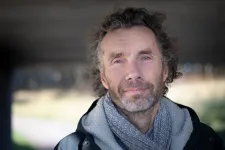(Press-News.org) TUCSON, Arizona — University of Arizona Health Sciences researchers are taking the foot off the brake in their quest to improve opioid therapy while decreasing its side effects.
Led by John Streicher, PhD, a Department of Pharmacology associate professor in the UArizona College of Medicine – Tucson and a member of the UArizona Health Sciences Comprehensive Pain and Addiction Center, the researchers have expanded upon their previous research focused on one specific protein – heat shock protein 90 – and its role in opioid receptor activation and pain relief. Their prior investigations have found that inhibiting Hsp90 in signaling pathways in the spinal cord has an important role in enhancing the effectiveness and decreasing the side effects of opioid therapy.
Dr. Streicher’s research team has demonstrated that Hsp90 can prevent pathways in the spinal cord from producing the natural pain relief responses that they are designed to do in the body. To overcome this, they have been studying drugs that can inhibit the activation of Hsp90 in animal models. Their work has shown that using these inhibitors unblocks the pathway and provides another route for improved pain relief.
"Once we established the important role that this protein has in the spinal cord, we wanted to explore how it regulates pain," Dr. Streicher said. "We have been digging further into the mechanisms that make this a druggable target so that we can more precisely translate it to the clinic."
The new research published in Science Signaling, provides additional insight into one of the foundational mechanisms that supports the role of Hsp90 in pain relief. The study focused on adenosine monophosphate-activated protein kinase. AMPK is a protein that has been connected to pain and is the target of several drugs, including Metformin, an anti-diabetic medication.
Previous research has identified a relationship between AMPK and pain to suggest that activation of the protein reduces pain. However, Dr. Streicher’s research has found a new connection when it comes to modulating pain with opioid therapy: AMPK can act to block or reduce pain relief by opioids.
“There is a subtle distinction between modulating pain and, in our case, modulating pain relief by the opioids,” said Dr. Streicher, who co-wrote the manuscript along with Katherin Gabriel, PhD, who earned a doctoral degree from the College of Medicine – Tucson. “Our paper goes into detail figuring out what AMPK is doing, the neurons it is expressed in and generally what is causing it to reduce pain relief. This provides a mechanistic foundation for our translational work to develop drugs as real clinical treatment options.”
Dr. Streicher’s team found that one of the effects of using the Hsp90 inhibitors was that the drugs also helped to overcome an opioid-induced negative feedback loop regulated by AMPK. In this context, AMPK acts as a braking system to shut down the pain relief pathway and prevents the potential benefits of opioids. However, the Hsp90 inhibitors can disable this feedback loop, opening the door for increased effectiveness and lower dosage of opioids.
“I think of this negative feedback loop as one foot on the gas pedal and the other foot on the brake. If you put your foot a little heavier on the gas, things get activated. And if you put one foot on the brake a little bit harder, now you’re going slow down that activation,” Dr. Streicher said.
“In terms of opioids for pain relief, AMPK is the foot on the brake. When we inhibit Hsp90, we’re taking our foot off that brake and that allows us to enhance the efficacy of opioids.”
The findings are additional evidence that Hsp90 inhibitors could give doctors the opportunity to implement a dose-reduction strategy for patients. Less opioid drug could be prescribed, but patients would get the same levels of pain relief while experiencing lower side effects.
When an opioid such as morphine enters the body, it binds to a protein target called the mu-opioid receptor (MOR) and launches a series of effects known as a signaling cascade. As signaling molecules work their way downstream, some cause positive effects, such as pain relief. Others result in negative side effects, such as: respiratory depression, which can cause death; reward, which can lead to addiction; and tolerance, which can increase the quantity of drug needed to provide the same amount of pain relief.
In his lab, Dr. Streicher is continuing research into how Hsp90 works in the spinal cord to amplify the analgesic effects of opioids, including studying a previously unknown signaling circuit in the spinal cord that was discovered during a previous study. Working with the College of Medicine – Tucson’s Quantitative Proteomics Laboratory, Dr. Streicher and his team have identified more than 200 proteins that may provide additional insight on how MOR signaling is organized in the spinal cord.
The new findings could have further translational impacts for patients who use AMPK drugs, such as Metformin, for conditions like diabetic neuropathy.
“This is speculative, but perhaps one of the reasons it is very hard to treat these patients with opioids is because other medications that target AMPK are interfering with what the opioids are intended to do,” Dr. Streicher said.
The prospects for developing a clinical Hsp90-inhibitor drug are promising, as several cancer researchers are studying Hsp90 inhibitors and demonstrating strong proof-of-concept in the lab. Still, approval by the U.S. Food and Drug Administration is likely years away.
“The goal of our research is to understand how opioids and pain work and to develop the ability to make a drug that’s going to improve opioid therapy. This is another step in the path that gets us closer to making that a reality,” Dr. Streicher said.
This work was supported by an Arizona Biomedical Research Commission New Investigator Award #ADHS18-198875, a National Institutes of Health grant R01DA052340, and institutional funds from the University of Arizona.
END
UArizona Health Sciences researchers unlocking new answers in the quest for safer, more effective opioid therapy
A University of Arizona Health Sciences study uncovered new ways in which Hsp90-inhibitor drugs in the spinal cord are showing promise as potential pain therapeutics.
2023-05-15
ELSE PRESS RELEASES FROM THIS DATE:
Dr. Laura Moyer elected as Fellow of ASM International
2023-05-15
Dr. Laura Moyer ’99 ’02G ’05 PhD, manager of metallography, light optical microscopy, and X-ray diffraction at Lehigh University, has been elected as a Fellow of ASM International, the leading association of engineers and scientists in the field of materials science.
The honor recognizes Moyer’s “outstanding leadership and technical contributions to the education of personnel in both manufacturing and academia,” benefitting the field of materials science and engineering. The ...
Researchers design smaller, lighter space-based imaging spectrometers with high spectral resolution
2023-05-15
Researchers have developed a new smaller, lighter design for space-based imaging spectrometers with high spectral resolution. These high-dispersion imaging spectrometers could be used onboard spacecraft or satellites to study the Earth’s atmosphere or the atmospheres of other planets.
James P. McGuire, Jr. from NASA’s Jet Propulsion Laboratory in Southern California will present the new research at the Optica Design and Fabrication Conference, which will take place 04 – 08 June 2023 in Quebec City, Canada.
“This spectrometer provides the same measurement capabilities as conventional designs, but at one tenth the ...
Sleep Research Society announces 2023 award recipients
2023-05-15
DARIEN, IL – Four individuals have been selected as the 2023 Sleep Research Society award recipients for their outstanding contributions to the SRS, sleep and circadian science, and public health. They will be recognized Monday, June 5, during the plenary session of the SLEEP 2023 annual meeting of the Associated Professional Sleep Societies in Indianapolis.
“The SRS awards recognize the highest achievements by sleep and circadian scientists whose work supports our mission to cultivate knowledge in the field and to optimize health and well-being,” said SRS President Namni Goel. “I congratulate these leaders ...
Physicists take the temperature of fluid flows and discover new role for turbulence
2023-05-15
A team of physicists has discovered a new role for a specific type of turbulence—a finding that sheds light on fluid flows ranging from the Earth’s liquid core to boiling water.
The research, which appears in the journal Proceedings of the National Academy of Sciences, centered on turbulent convection—the movement of fluid when heated from below.
“Our experiments reveal intricate movements between a free-moving body and thermal convective flows,” says Jun Zhang, a professor of mathematics and physics at New York University and NYU Shanghai, the paper’s senior author.
The study, which also included Kaizhe Wang, a researcher ...
Tiny proteins found across the animal kingdom play a key role in cancer spread
2023-05-15
Phosphatases of regenerating liver (PRLs) are a family of enigmatic proteins involved in cell growth and metabolism present in various species. From humans to fruit flies, they play a unique role in the growth of cancerous tumours and the spread of cancer throughout the body. New research emerging from McGill University is contributing to what is known about PRLs, which could potentially become an important tool in the development of cancer-fighting treatments.
Led by Kalle Gehring, a professor in the Department of Biochemistry and founding director of the McGill Centre for Structural Biology, the researchers focused on unravelling the mystery around PRLs. “It's ...
Great inequality in international athletics
2023-05-15
Athletes from less affluent countries need more education on health to prevent injuries during hard training. But, paradoxically, more knowledge can also increase the risk of injury if there is no access to medically trained expertise. This is the conclusion of researchers at Linköping University, Sweden, in a new study on inequality in athletics.
“There were astronomical differences in support resources between juniors from different parts of the world. European competitors had entire medical teams and computer-based analysis programs ...
New DOE portal connects researchers and students with climate science and training opportunities
2023-05-15
The National Virtual Climate Laboratory (NVCL), a comprehensive web portal for climate science projects funded by the U.S. Department of Energy (DOE) Office of Science’s Biological and Environmental Research (BER) program, is now available.
The NVCL is a portal for those who have a stake in the climate crisis, such as researchers, students, faculty, and other interested organizations. Portal users will be able to find a wide range of national laboratory experts, programs, projects, activities, ...
Alternating estrogen and anti-estrogen therapies is effective in treating metastatic breast cancer
2023-05-15
LEBANON, NH— Advanced or metastatic estrogen receptor-positive (ER+) breast cancer is commonly treated with drugs that block the estrogen receptor. However, estrogens that stimulate the receptor can also be effective. Building on their previous studies, researchers at Dartmouth Cancer Center recently concluded a Phase II clinical trial aimed to test the efficacy of alternating between estrogen stimulation and estrogen deprivation in patients with metastatic ER+ breast cancer, and to identify tumor characteristics that predict who might benefit from this strategy. The results, newly published ahead of print in Clinical ...
'Love hormone' guides young songbirds in choice of 'voice coach'
2023-05-15
Oxytocin, the so-called “love hormone,” plays a key role in the process of how a young zebra finch learns to sing by imitating its elders, suggests a new study by neuroscientists at Emory University. Scientific Reports published the findings, which add to the understanding of the neurochemistry of social learning.
“We found that the oxytocin system is involved from an early age in male zebra finches learning song,” says Natalie Pilgeram, first author of the study and an Emory PhD candidate in psychology. “It’s basic science that may lead to insights into the ...
Researchers find compound that combats multidrug-resistant bacteria in less than one hour
2023-05-15
Resistance to antibiotics is a problem that alarms the medical and scientific community. Bacteria resistant to three different classes of antibiotics, known as multi-drug resistant (MDR) bacteria, are far from rare. Some are even resistant to all currently available treatments and are known as pan-drug resistant (PDR). They are associated with dangerous infections and listed by the World Health Organization (WHO) as priority pathogens for drug development with maximum urgency.
An article published in a special issue of the journal Antibiotics highlights a compound with antibacterial activity that presented promising ...
LAST 30 PRESS RELEASES:
Plant hormone allows lifelong control of proteins in living animal for first time
Swedish freshwater bacteria give new insights into bacterial evolution
Global measures consistently underestimate food insecurity; one in five who suffer from hunger may go uncounted
Hidden patterns of isolation and segregation found in all American cities
FDA drug trials exclude a widening slice of Americans
Sea reptile’s tooth shows that mosasaurs could live in freshwater
Pure bred: New stem cell medium only has canine components
Largest study of its kind highlights benefits – and risks – of plant-based diets in children
Synergistic effects of single-crystal HfB2 nanorods: Simultaneous enhancement of mechanical properties and ablation resistance
Mysterious X-ray variability of the strongly magnetized neutron star NGC 7793 P13
The key to increasing patients’ advance care medical planning may be automatic patient outreach
Palaeontology: Ancient tooth suggests ocean predator could hunt in rivers
Polar bears may be adapting to survive warmer climates, says study
Canadian wildfire smoke worsened pediatric asthma in US Northeast: UVM study
New UBCO research challenges traditional teen suicide prevention models
Diversity language in US medical research agency grants declined 25% since 2024
Concern over growing use of AI chatbots to stave off loneliness
Biomedical authors often call a reference “recent” — even when it is decades old, analysis shows
The Lancet: New single dose oral treatment for gonorrhoea effectively combats drug-resistant infections, trial finds
Proton therapy shows survival benefit in Phase III trial for patients with head and neck cancers
Blood test reveals prognosis after cardiac arrest
UBCO study finds microdosing can temporarily improve mood, creativity
An ECOG-ACRIN imaging study solves a long-standing gap in metastatic breast cancer research and care: accurately measuring treatment response in patients with bone metastases
Cleveland Clinic presents final results of phase 1 clinical trial of preventive breast cancer vaccine study
Nationally renowned anesthesiology physician-scientist and clinical operations leader David Mintz, MD, PhD, named Chair of the Department of Anesthesiology at the UM School of Medicine
Clean water access improves child health in Mozambique, study shows
Study implicates enzyme in neurodegenerative conditions
Tufts professor named Fellow of the National Academy of Inventors
Tiny new device could enable giant future quantum computers
Tracing a path through photosynthesis to food security
[Press-News.org] UArizona Health Sciences researchers unlocking new answers in the quest for safer, more effective opioid therapyA University of Arizona Health Sciences study uncovered new ways in which Hsp90-inhibitor drugs in the spinal cord are showing promise as potential pain therapeutics.





